brakes MERCEDES-BENZ S CLASS 2019 Owners Manual
[x] Cancel search | Manufacturer: MERCEDES-BENZ, Model Year: 2019, Model line: S CLASS, Model: MERCEDES-BENZ S CLASS 2019Pages: 578, PDF Size: 23.31 MB
Page 28 of 578
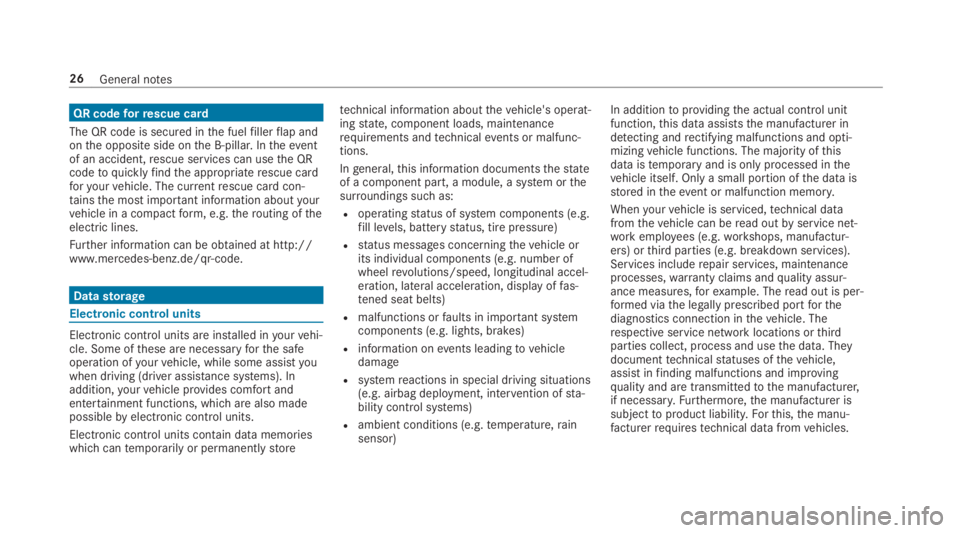
QR codeforrescue card
The QR code is secured inthe fuelfillerflap andonthe opposite side onthe B-pillar. Intheeventof an accident,rescue services can usethe QRcodetoquicklyfindthe appropriaterescue cardforyourvehicle. The currentrescue card con‐tainsthe most important information aboutyourvehicle in a compactform, e.g.therouting oftheelectric lines.
Further information can be obtained at http://www.mercedes-benz.de/qr-code.
Datastorage
Electronic control units
Electronic control units are installed inyourvehi‐cle. Some ofthese are necessaryforthe safeoperation ofyourvehicle, while some assistyouwhen driving (driver assistance systems). Inaddition,yourvehicle provides comfortandentertainment functions, which are also madepossiblebyelectronic control units.
Electronic control units contain datamemorieswhichcantemporarily or permanentlystore
technical information aboutthevehicle's operat‐ingstate, component loads, maintenancerequirements andtechnicalevents or malfunc‐tions.
Ingeneral,this information documentsthestateof a component part, a module, a system orthesurroundings such as:
Roperatingstatus of system components (e.g.fill levels, batterystatus, tire pressure)
Rstatus messages concerningthevehicle orits individual components (e.g. number ofwheelrevolutions/speed, longitudinal accel‐eration, lateral acceleration, display offas‐tened seat belts)
Rmalfunctions orfaults in important systemcomponents (e.g. lights, brakes)
Rinformation onevents leadingtovehicledamage
Rsystemreactions in special driving situations(e.g. airbag deployment, intervention ofsta‐bility control systems)
Rambient conditions (e.g.temperature,rainsensor)
In additiontoprovidingthe actual control unitfunction,this data assiststhe manufacturer indetecting andrectifying malfunctions and opti‐mizingvehicle functions. The majority ofthisdata istemporary and is only processed inthevehicle itself. Only a small portion ofthe data isstored intheevent or malfunction memory.
Whenyourvehicle is serviced,technical datafromthevehicle can beread outbyservice net‐workemployees (e.g.workshops, manufactur‐ers) orthird parties (e.g. breakdown services).Services includerepair services, maintenanceprocesses,warranty claims andquality assur‐ance measures,forexample. Theread out is per‐formed viathe legally prescribed portforthediagnostics connection inthevehicle. Therespective service network locations orthirdparties collect, process and usethe data. Theydocumenttechnicalstatuses ofthevehicle,assist infinding malfunctions and improvingquality and are transmittedtothe manufacturer,if necessary.Furthermore,the manufacturer issubjecttoproduct liability.Forthis,the manu‐facturerrequirestechnical datafromvehicles.
26General notes
Page 195 of 578
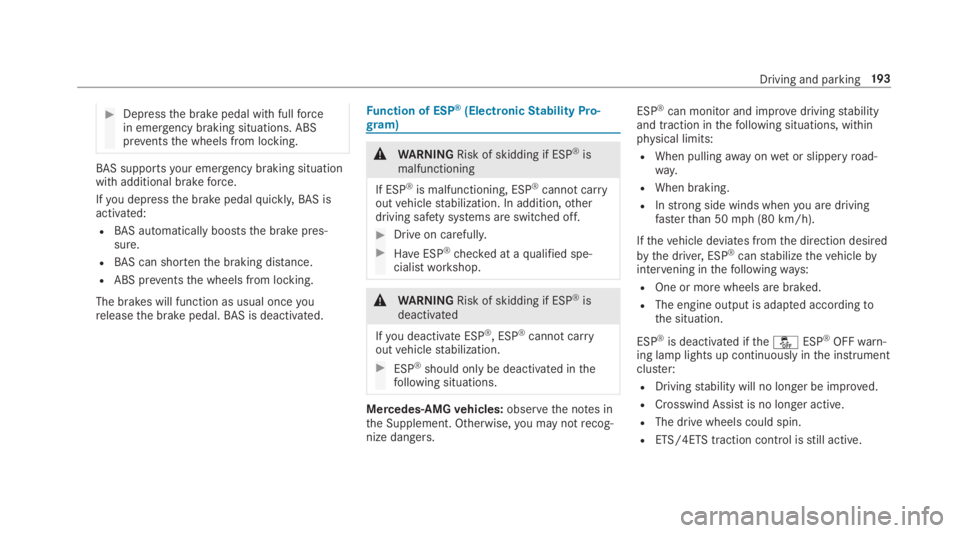
#Depressthe brake pedal with fullforcein emergency braking situations. ABSpreventsthe wheels from locking.
BAS supportsyour emergency braking situationwith additional brakeforce.
Ifyou depressthe brake pedalquickly,BAS isactivated:
RBAS automaticallybooststhe brake pres‐sure.
RBAS can shortenthe braking distance.
RABS preventsthe wheels from locking.
The brakes will function as usual onceyoureleasethe brake pedal.BAS is deactivated.
Function of ESP®(ElectronicStability Pro‐gram)
&WARNINGRisk of skidding if ESP®ismalfunctioning
If ESP®is malfunctioning, ESP®cannot carryoutvehiclestabilization. In addition,otherdriving safety systems are switched off.
#Drive on carefully.
#HaveESP®checked at aqualified spe‐cialistworkshop.
&WARNINGRisk of skidding if ESP®isdeactivated
Ifyou deactivate ESP®, ESP®cannot carryoutvehiclestabilization.
#ESP®should onlybe deactivated inthefollowing situations.
Mercedes‑AMGvehicles:observethe notes inthe Supplement. Otherwise,you may notrecog‐nize dangers.
ESP®can monitor and improvedrivingstabilityand traction inthefollowing situations, withinphysical limits:
RWhen pullingawayonwet or slipperyroad‐way.
RWhen braking.
RInstrong side winds whenyou are drivingfasterthan 50mph (80 km/h).
Ifthevehicle deviates fromthe direction desired
bythe driver, ESP®canstabilizethevehiclebyintervening inthefollowingways:
ROne or more wheels are braked.
RThe engine output is adapted accordingtothe situation.
ESP®is deactivated ifthe�
Page 203 of 578
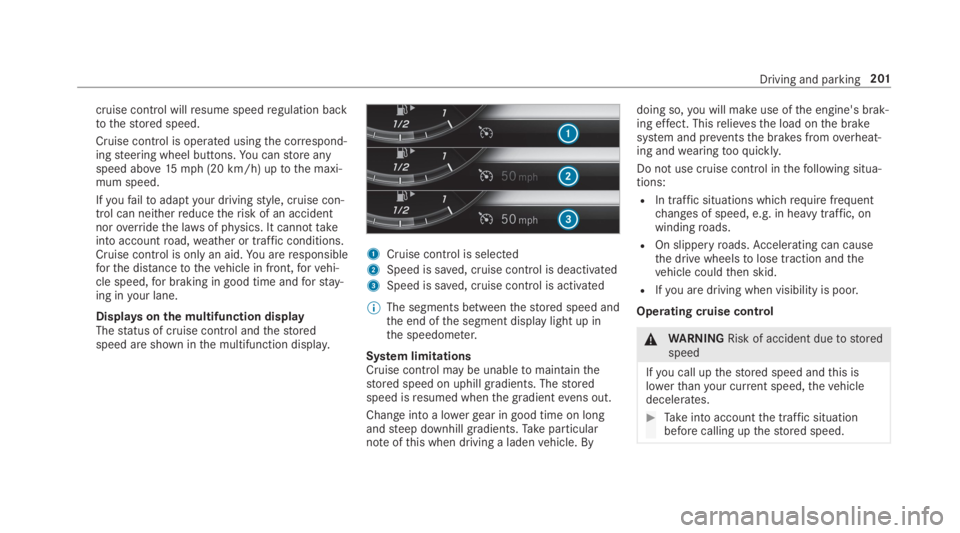
cruise control willresume speedregulation backtothestored speed.
Cruise control is operated usingthe correspond‐ingsteering wheel buttons.You canstore anyspeed above15mph (20 km/h) uptothe maxi‐mum speed.
Ifyoufailtoadaptyour drivingstyle, cruise con‐trol can neitherreducetherisk of an accidentnoroverridethe lawsof physics. It cannottakeinto accountroad,weather or traffic conditions.Cruise control is only an aid.You areresponsibleforthe distancetothevehicle in front,forvehi‐cle speed,for braking in good time andforstay‐ing inyour lane.
Displaysonthe multifunction displayThestatus of cruise control andthestoredspeed are shown inthe multifunction display.
1Cruise control is selected
2Speed is saved, cruise control is deactivated
3Speed is saved, cruise control is activated
%The segments betweenthestored speed andthe end ofthe segment display light up inthe speedometer.
System limitationsCruise control may be unabletomaintainthestored speed on uphill gradients. Thestoredspeed isresumed whenthe gradientevens out.
Change into a lowergear in good time on longandsteep downhill gradients.Takeparticularnoteofthis when driving a ladenvehicle. By
doing so,you will make use ofthe engine's brak‐ing effect. Thisrelievesthe load onthe brakesystem and preventsthe brakes fromoverheat‐ing andwearingtooquickly.
Do not use cruise control inthefollowing situa‐tions:
RIn traffic situations whichrequire frequentchanges of speed, e.g. in heavy traffic, onwindingroads.
ROn slipperyroads.Accelerating can causethe drive wheelstolose traction andthevehicle couldthen skid.
RIfyou are driving when visibility is poor.
Operating cruise control
&WARNINGRisk of accident duetostoredspeed
Ifyou call upthestored speed andthis islowerthanyour current speed,thevehicledecelerates.
#Takeinto accountthe traffic situationbefore calling upthestored speed.
Driving and parking201
Page 205 of 578

Active Distance Assist DISTRONIC
Function ofActive Distance AssistDISTRONIC
Active Distance AssistDISTRONIC maintainstheset speed on free-flowingroads. Ifvehicles infront are detected,the set distance is main‐tained, if necessary,untilthevehicle comesto ahalt. Thevehicle accelerates or brakes depend‐ing onthe distancetothevehicle in front andthe set speed. The speed (intherange between15mph (20 km/h) and130mph (210km/h))andthe distancetothevehicle in front are setand saved onthesteering wheel.
Otherfeatures ofActive Distance AssistDISTRONIC:
RAdjuststhe drivingstyle depending ontheselected drive program (fuel-saving, comfort‐able or dynamic) (→page175)
RReactstostationaryvehicles detected inurban speedranges (except bicycles andmotorcycles)
RInitiates accelerationtothestored speed ifthe turn signal indicator is switched ontochangetotheovertaking lane.
RTakes one-sidedovertakingrestrictions intoaccount on highways or on multi-laneroadswith separateroadways (country-dependent).
Vehicles withActiveParking Assist:ifthevehicle has been brakedtoastandstill on multi-lane, separateroadwaysbyActive DistanceAssistDISTRONIC, it can automaticallyfollowthevehicle in front driving off again within30 seconds. If a critical situation is detectedwhen driving off, a visual and acousticwarning isgiven indicatingthatthe driver must nowtakecontrol ofthevehicle. Thevehicle is not acceler‐ated any further.
Active Distance AssistDISTRONIC is only an aid.The driver isresponsibleforkeeping a safe dis‐tancetothevehicle in front,forvehicle speedandfor braking in good time.
System limitations
The system may be impaired or may not functioninthefollowing instances:
RIn snow,rain,fog, heavy spray, ifthere isglare, in direct sunlight or in greatlyvaryingambient light.
RThe windshield inthe area ofthe camera isdirty,fogged up, damaged or covered.
RIftheradar sensors are dirty or covered.
RIn parkinggarages or onroads withsteepuphill or downhill gradients.
RIfthere are narrowvehicles in front, such asbicycles or motorcycles.
In addition, on slipperyroads, braking or accel‐erating can cause one or several wheelstolosetraction andthevehicle couldthen skid.
Do not useActive Distance AssistDISTRONIC inthese situations.
Driving and parking203
Page 206 of 578
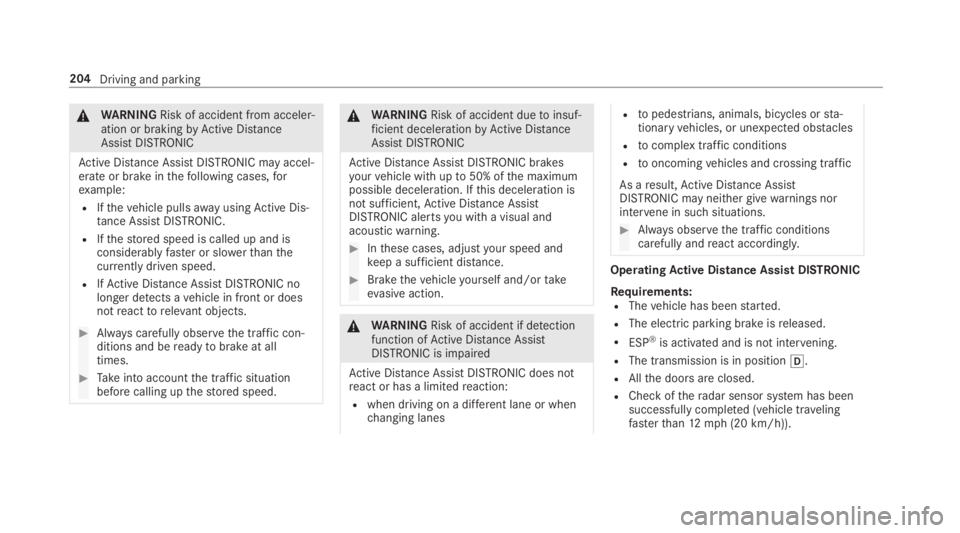
&WARNINGRisk of accident from acceler‐ation or brakingbyActive DistanceAssistDISTRONIC
Active Distance AssistDISTRONIC may accel‐erate or brake inthefollowing cases,forexample:
RIfthevehicle pullsawayusingActive Dis‐tance AssistDISTRONIC.
RIfthestored speed is called up and isconsiderablyfaster or slowerthanthecurrently driven speed.
RIfActive Distance AssistDISTRONIC nolonger detects avehicle in front or doesnotreacttorelevant objects.
#Always carefully observethe traffic con‐ditions and bereadytobrake at alltimes.
#Takeinto accountthe traffic situationbefore calling upthestored speed.
&WARNINGRisk of accident duetoinsuf‐ficient decelerationbyActive DistanceAssistDISTRONIC
Active Distance AssistDISTRONIC brakesyourvehicle with upto50% ofthe maximumpossible deceleration. Ifthis deceleration isnot sufficient,Active Distance AssistDISTRONIC alertsyou with a visual andacousticwarning.
#Inthese cases, adjustyour speed andkeep a sufficient distance.
#Brakethevehicleyourself and/ortakeevasive action.
&WARNINGRisk of accident if detectionfunction ofActive Distance AssistDISTRONIC is impaired
Active Distance AssistDISTRONIC does notreact or has a limitedreaction:
Rwhen driving on a different lane or whenchanging lanes
Rtopedestrians, animals, bicycles orsta‐tionaryvehicles, or unexpected obstacles
Rtocomplextraffic conditions
Rtooncomingvehicles and crossing traffic
As aresult,Active Distance AssistDISTRONIC may neither givewarnings norintervene in suchsituations.
#Always observethe traffic conditionscarefully andreact accordingly.
OperatingActive Distance Assist DISTRONIC
Requirements:RThevehicle has beenstarted.
RThe electric parking brake isreleased.
RESP®is activated and is not intervening.
RThe transmission is in position�[.
RAllthe doors are closed.
RCheck oftheradar sensor system has beensuccessfully completed (vehicle travelingfasterthan12mph (20 km/h)).
204Driving and parking
Page 216 of 578
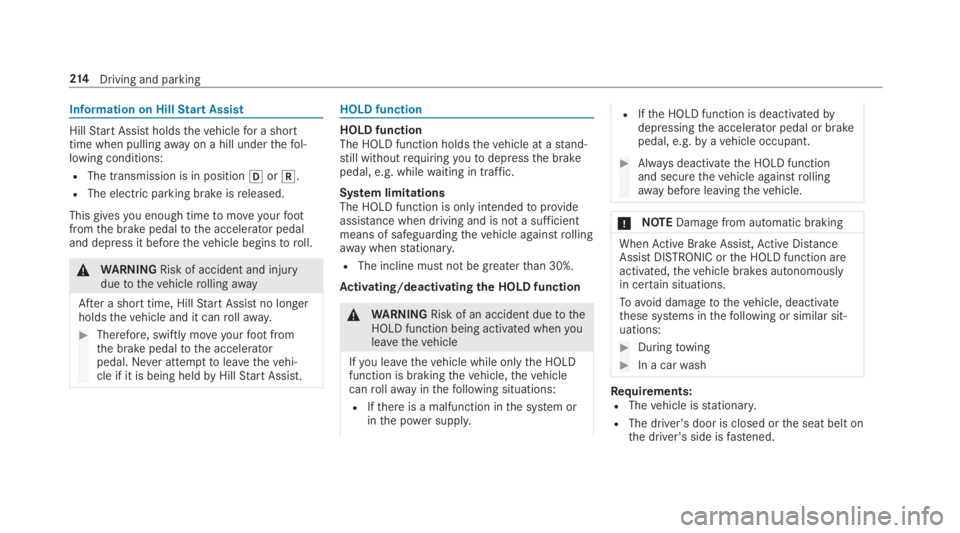
Information on HillStart Assist
HillStart Assist holdsthevehiclefor a shorttime when pullingawayon a hill underthefol‐lowing conditions:
RThe transmission is in position�[or�^.
RThe electric parking brake isreleased.
This givesyou enough timetomoveyourfootfromthe brake pedaltothe accelerator pedaland depress it beforethevehicle beginstoroll.
&WARNINGRisk of accident and injuryduetothevehiclerollingaway
After a short time, HillStart Assist no longerholdsthevehicle and it canrollaway.
#Therefore, swiftly moveyourfootfromthe brake pedaltothe acceleratorpedal. Never attempttoleavethevehi‐cle if it is being heldbyHillStart Assist.
HOLD function
HOLD functionThe HOLD function holdsthevehicle at astand‐still withoutrequiringyoutodepressthe brakepedal, e.g. whilewaiting in traffic.
System limitationsThe HOLD function is only intendedtoprovideassistance when driving and is not a sufficientmeans of safeguardingthevehicle againstrollingawaywhenstationary.
RThe incline must not be greaterthan 30%.
Activating/deactivating the HOLD function
&WARNINGRisk of an accident duetotheHOLD function being activated whenyouleavethevehicle
Ifyou leavethevehicle while onlythe HOLDfunction is brakingthevehicle,thevehiclecanrollawayinthefollowing situations:
RIfthere is a malfunction inthe system orinthe power supply.
RIfthe HOLD function is deactivatedbydepressingthe accelerator pedal or brakepedal, e.g.byavehicle occupant.
#Always deactivatethe HOLD functionand securethevehicle againstrollingawaybefore leavingthevehicle.
*NOTEDamagefrom automatic braking
WhenActive Brake Assist,Active DistanceAssistDISTRONIC orthe HOLD function areactivated,thevehicle brakes autonomouslyin certain situations.
Toavoid damagetothevehicle, deactivatethese systems inthefollowing or similar sit‐uations:
#Duringtowing
#In a carwash
Requirements:RThevehicle isstationary.
RThe driver's door is closed orthe seat belt onthe driver's side isfastened.
214Driving and parking
Page 455 of 578
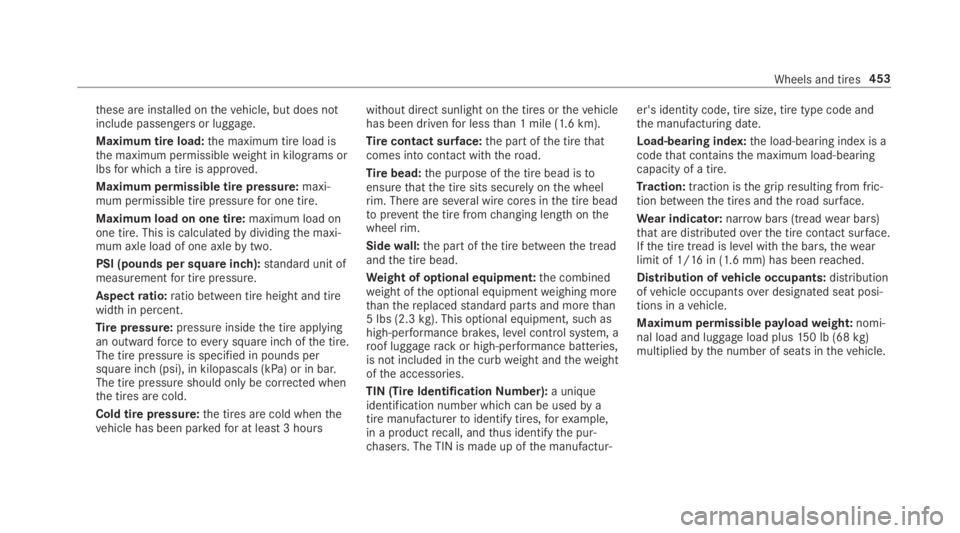
these are installed onthevehicle, but does notinclude passengers or luggage.
Maximum tire load:the maximum tire load isthe maximum permissibleweight in kilograms orlbsfor whicha tire is approved.
Maximum permissible tire pressure:maxi‐mum permissible tire pressurefor one tire.
Maximum load on one tire:maximum load onone tire. This is calculatedbydividingthe maxi‐mum axle load of one axlebytwo.
PSI (pounds per square inch):standard unit ofmeasurementfor tire pressure.
Aspectratio:ratio between tire height and tirewidth in percent.
Tirepressure:pressure insidethe tire applyingan outwardforcetoeverysquare inch ofthe tire.The tire pressure is specified in pounds persquare inch (psi), in kilopascals (kPa) or in bar.The tire pressure should only be corrected whenthe tires are cold.
Cold tire pressure:the tires are cold whenthevehicle has been parkedfor at least3 hours
without direct sunlight onthe tires orthevehiclehas been drivenfor lessthan 1 mile (1.6 km).
Tirecontact surface:the part ofthe tirethatcomes into contact with theroad.
Tirebead:the purpose ofthe tire bead istoensurethatthe tire sits securely onthe wheelrim. There are several wire cores inthe tire beadtopreventthe tire fromchanging length onthewheelrim.
Sidewall:the part ofthe tire betweenthe treadandthe tire bead.
Weight of optional equipment:the combinedweight ofthe optional equipmentweighing morethanthereplacedstandard parts and morethan5 lbs (2.3kg).This optional equipment, such ashigh-performance brakes, level control system, aroof luggagerackor high-performance batteries,is not included inthe curbweight andtheweightofthe accessories.
TIN (Tire IdentificationNumber):a uniqueidentification number which can be usedby atire manufacturertoidentify tires,forexample,in a productrecall, andthus identifythe pur‐chasers. The TIN is made up ofthe manufactur‐
er's identity code, tire size, tire type code andthe manufacturing date.
Load-bearing index:the load-bearing index is acodethat containsthe maximum load-bearingcapacity of a tire.
Traction:traction isthe gripresulting from fric‐tion betweenthe tires andtheroad surface.
Wear indicator:narrowbars (treadwear bars)that are distributedoverthe tire contact surface.Ifthe tire tread is level withthe bars,thewearlimit of 1/16in (1.6 mm) has beenreached.
Distribution ofvehicle occupants:distributionofvehicle occupantsover designated seat posi‐tions in avehicle.
Maximum permissible payloadweight:nomi‐nal load and luggage load plus150 lb (68kg)multipliedbythe number of seats inthevehicle.
Wheels and tires453
Page 456 of 578
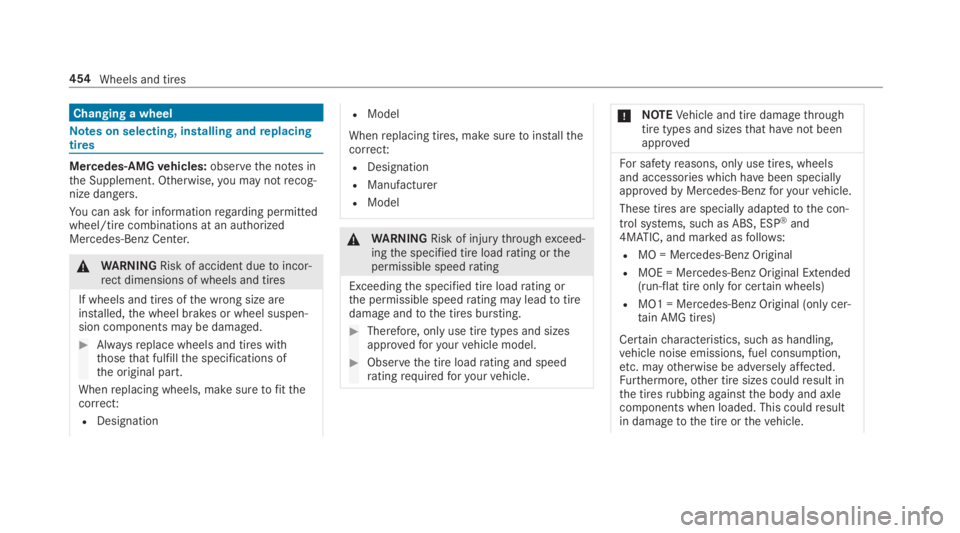
Changing a wheel
Notes on selecting, installing andreplacingtires
Mercedes-AMGvehicles:observethe notes inthe Supplement. Otherwise,you may notrecog‐nize dangers.
You can askfor informationregarding permittedwheel/tire combinations at an authorizedMercedes-Benz Center.
&WARNINGRisk of accident duetoincor‐rect dimensions of wheels and tires
If wheels and tires ofthe wrong size areinstalled,the wheel brakes or wheel suspen‐sion components may be damaged.
#Alwaysreplace wheels and tires withthosethat fulfillthe specifications ofthe original part.
Whenreplacing wheels, make suretofitthecorrect:
RDesignation
RModel
Whenreplacing tires, make suretoinstallthecorrect:
RDesignation
RManufacturer
RModel
&WARNINGRisk of injurythroughexceed‐ingthe specified tire loadrating orthepermissible speedrating
Exceedingthe specified tire loadrating orthe permissible speedrating may leadtotiredamageandtothe tires bursting.
#Therefore, only use tire types and sizesapprovedforyourvehicle model.
#Observethe tire loadrating and speedratingrequiredforyourvehicle.
*NOTEVehicle and tire damagethroughtire types and sizesthat havenot beenapproved
For safetyreasons, onlyuse tires, wheelsand accessories which havebeen speciallyapprovedbyMercedes-Benzforyourvehicle.
These tires are specially adaptedtothe con‐
trol systems, such as ABS, ESP®and4MATIC, and marked asfollows:
RMO = Mercedes-Benz Original
RMOE = Mercedes-Benz Original Extended(run-flat tire onlyfor certain wheels)
RMO1 = Mercedes-Benz Original (only cer‐tain AMG tires)
Certaincharacteristics, such as handling,vehicle noise emissions, fuel consumption,etc. mayotherwise be adversely affected.Furthermore,other tire sizes couldresult inthe tiresrubbing againstthe body and axlecomponents when loaded. This couldresultin damagetothe tire orthevehicle.
454Wheels and tires
Page 458 of 578
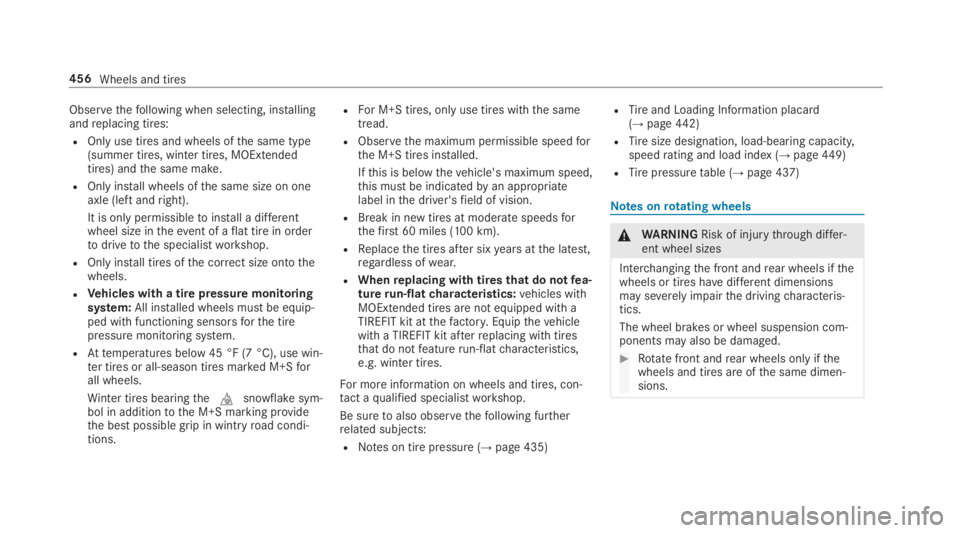
Observethefollowing when selecting, installingandreplacing tires:
ROnly use tires and wheels ofthe same type(summer tires, winter tires, MOExtendedtires) andthe same make.
ROnly install wheels ofthe same size on oneaxle (left andright).
It is only permissibletoinstall a differentwheel size intheevent of aflat tire in ordertodrivetothe specialistworkshop.
ROnly install tires ofthe correct size ontothewheels.
RVehicles with a tire pressure monitoringsystem:All installed wheels must be equip‐ped with functioning sensorsforthe tirepressure monitoring system.
RAttemperatures below 45 °F (7 °C), use win‐ter tires or all-season tires marked M+Sforall wheels.
Winter tires bearingthe�Msnowflake sym‐bol in additiontothe M+S marking providethe best possible grip in wintryroad condi‐tions.
RFor M+S tires, only use tires withthe sametread.
RObservethe maximum permissible speedforthe M+S tires installed.
Ifthis is belowthevehicle's maximum speed,this must be indicatedbyan appropriatelabel inthe driver'sfield of vision.
RBreak in new tires at moderate speedsforthefirst 60 miles (100 km).
RReplacethe tires after sixyears atthe latest,regardless ofwear.
RWhenreplacing with tires that do notfea‐turerun-flatcharacteristics:vehicles withMOExtended tires are not equipped with aTIREFIT kit atthefactory.Equipthevehiclewith a TIREFIT kit afterreplacing with tiresthat do notfeaturerun-flatcharacteristics,e.g. winter tires.
For more information on wheels and tires, con‐tact aqualified specialistworkshop.
Be suretoalso observethefollowing furtherrelated subjects:
RNotes on tire pressure (→page 435)
RTireand Loading Information placard(→page442)
RTiresize designation, load-bearing capacity,speedrating and load index (→page449)
RTirepressuretable (→page 437)
Notes onrotating wheels
&WARNINGRisk of injurythrough differ‐ent wheel sizes
Interchangingthe front andrear wheels ifthewheels or tires havedifferent dimensionsmay severely impairthe drivingcharacteris‐tics.
The wheel brakes or wheel suspension com‐ponents may also be damaged.
#Rotatefront andrear wheels onlyifthewheels and tires are ofthe same dimen‐sions.
456Wheels and tires
Page 474 of 578
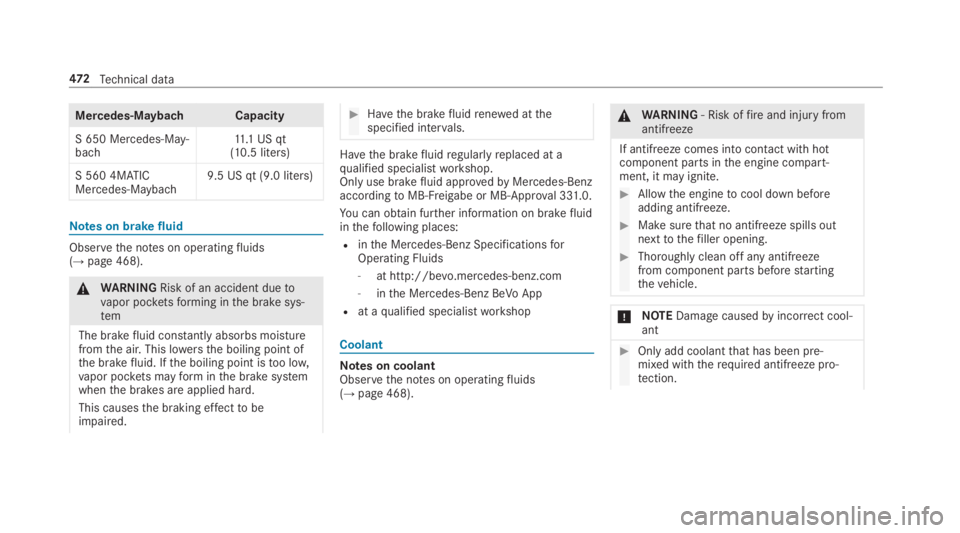
Mercedes‑MaybachCapacity
S 650 Mercedes-May‐bach11.1US qt(10.5 liters)
S 560 4MATICMercedes-Maybach9.5 US qt (9.0 liters)
Notes on brakefluid
Observethe notes on operatingfluids(→page 468).
&WARNINGRisk of an accident duetovapor pocketsforming inthe brake sys‐tem
The brakefluid constantly absorbs moisturefromthe air. This lowersthe boiling point ofthe brakefluid. Ifthe boiling point istoo low,vapor pockets mayforminthe brake systemwhenthe brakes are applied hard.
This causesthe braking effecttobeimpaired.
#Havethe brakefluidrenewed atthespecified intervals.
Havethe brakefluidregularlyreplaced at aqualified specialistworkshop.Only use brakefluid approvedbyMercedes-BenzaccordingtoMB-Freigabe or MB-Approval 331.0.
You can obtain further information on brakefluidinthefollowing places:
Rinthe Mercedes-Benz SpecificationsforOperating Fluids
-at http://bevo.mercedes-benz.com
-inthe Mercedes-Benz BeVo App
Rat aqualified specialistworkshop
Coolant
Notes on coolantObservethe notes on operatingfluids(→page 468).
&WARNING‑ Risk offireand injury fromantifreeze
If antifreeze comes into contact withhotcomponent parts inthe engine compart‐ment, it may ignite.
#Allowthe enginetocool down beforeadding antifreeze.
#Makesurethat no antifreeze spills outnexttothefiller opening.
#Thoroughly clean off any antifreezefrom component parts beforestartingthevehicle.
*NOTEDamagecausedbyincorrect cool‐ant
#Only add coolantthat has been pre‐mixed withtherequired antifreeze pro‐tection.
472Technical data